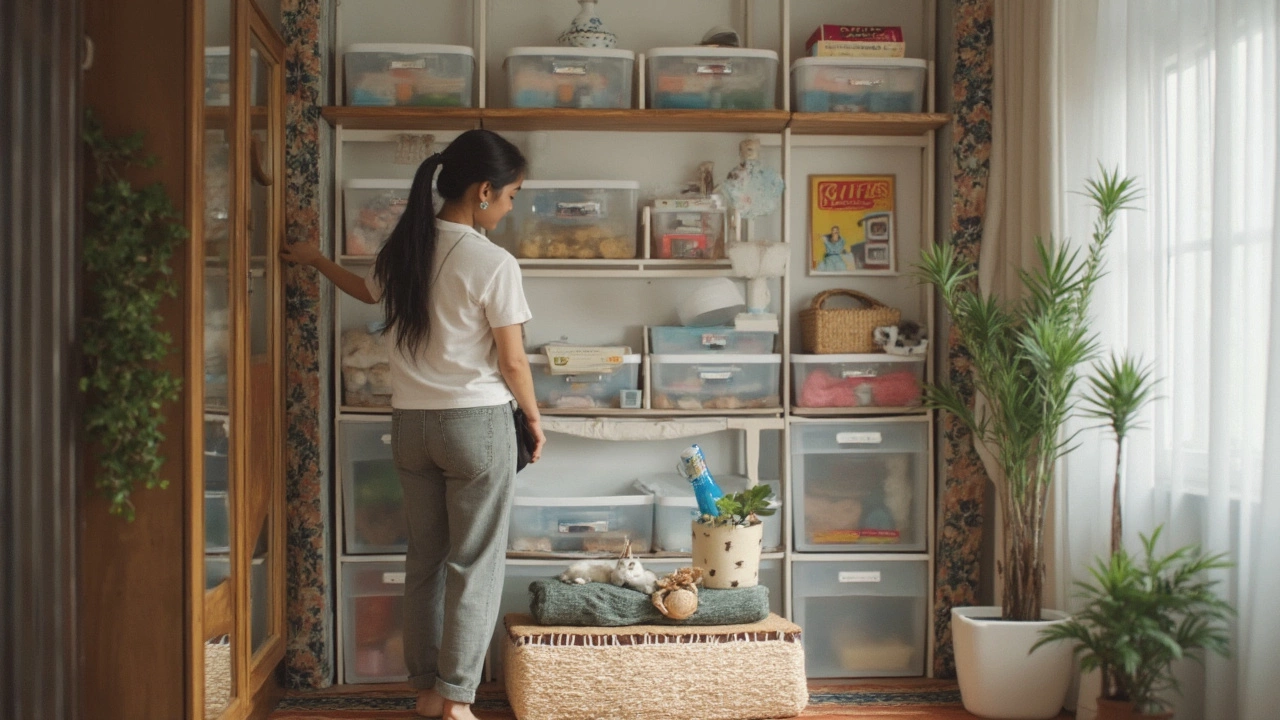Ever open a closet and wonder why you’re still hanging onto boxes you haven’t touched in years? Storage costs—whether it’s self-storage or just stuffed spare rooms—can quietly eat up cash and space. The average American home now has over 300,000 items. No joke. A lot of what we store could probably go, but most of us don’t know where to start.
The first step? Figure out exactly what you’re storing and why. Do you really need five old sports bags or stacks of holiday decorations you never use? Cutting down just a little can save you a lot—both at home and in outside storage units. The less stuff you own, the less you’ll spend cramming it into bins and boxes, and the more you’ll save when you stop renting that extra storage space or skip shelling out for new organizing tools.
Ready to bring down those storage bills and actually find what you need when you need it? You’re about to get tips that work for real families in real homes. Nothing fancy—just practical ways to cut down, keep things organized, and keep your money where it belongs: in your pocket.
- Rethink What You Store
- Declutter for Instant Savings
- Smart Storage Hacks Inside Your Home
- When You Need Extra Space: Save on Storage Units
- Cheap and Creative Alternatives
Rethink What You Store
If you want to reduce storage cost, you’ve got to start by looking at what’s taking up space. Most people hold on to way more than they need. According to a 2023 survey by the National Association of Professional Organizers, 54% of Americans feel overwhelmed by their clutter, yet 78% don’t know what to do with it. That’s a lot of stuff just gathering dust—and eating into your budget.
It helps to make a list of what you’re actually storing. You might be surprised by how many duplicates you’ve accumulated or how much you’re keeping "just in case." Kids outgrow toys and clothes, gadgets break or get replaced, and old furniture often just sits in corners or garages. These things all pile up fast.
- Scan your storage spaces: closets, attic, garage, and see what’s there.
- Group similar items together—this shows you how much of each type you really have.
- Ask yourself if you’ve used an item in the last year. If not, consider selling, donating, or recycling it.
- Think about sentimental items. Keep only what truly matters, not every keepsake you’ve ever collected.
To put things in perspective, check out this quick look at why stuff adds up so quickly at home:
| Item Category | Average Amount in US Homes | How Often Used |
|---|---|---|
| Clothing | Over 100 pieces per person | 40% worn yearly |
| Toys | ~71 per household | Kids play with just 7 regularly |
| Kitchen Gadgets | 30+ | Half used less than twice a year |
| Holiday Decorations | 6-10 bins | Used once a year |
It all boils down to this: reevaluating what you really need is the fastest way to trim your storage bill down. Next time you want to throw something in the "save for later" pile, think twice. Cutting down your stuff not only saves space, it makes life feel lighter too.
Declutter for Instant Savings
Too much stuff turns storage into a money pit. Here’s a wild fact: over 10% of households in the U.S. actually rent self-storage, mostly because they can’t fit everything at home. Decluttering cuts your storage needs fast, and if you do it right, you might never need to pay for extra space again.
The secret is being honest about what you really use. That 80/20 rule—where you use 20% of your things 80% of the time—applies here. Most people keep old gadgets, tangled cords, kids’ clothes, or piles of papers “just in case.” That just means more bins and more boxes taking up space, or worse, forcing you to rent a storage unit for stuff you’ll never use.
Here’s a straightforward way to declutter with immediate results:
- Start small—pick one shelf, one closet, or just the junk drawer. Don’t try to take on your whole house at once.
- Sort items into three piles: keep, toss, and donate/sell. Be ruthless, especially with duplicates and anything you haven’t used in over a year.
- If you’re unsure about something, box it up and write the date on it. If you haven’t touched it in six months, out it goes.
Your local donation center or online marketplace can turn unwanted stuff into cash or help someone in need. Get the kids involved too—studies show families are more likely to stick with home storage routines when everyone pitches in.
After one good decluttering session, you might find you have empty shelves and clear closets. That means fewer bins to buy, less time searching for things, and a solid chunk of monthly storage fees saved. Plus, your house just feels better without the clutter.

Smart Storage Hacks Inside Your Home
Paying big bucks for more space doesn’t make sense if you aren’t fully using what you already have. A quick fact: most people only use about 20% of the stuff they store regularly. The rest? It’s just taking up space. Here’s how you can make your home work smarter for you without blowing your budget.
- Vertical space is your best friend. Install shelves higher up on your walls or over doors. Think about the space above the bathroom door for spare towels. Use the backs of closet doors for hanging organizers—suddenly, that wasted air turns into bonus storage.
- Try under-bed storage bins. It’s dead space, but a few low plastic boxes or rolling drawers turn it into prime real estate for shoes, off-season clothes, or holiday decorations.
- Make furniture do double duty. A bench with hidden storage or an ottoman that opens up isn’t just for looks—it’s a stash spot for anything from board games to winter gloves.
- Clear containers keep you honest. Use see-through bins and label them, so you stop buying duplicates. The average household spends over $50 a year rebuying things they already own but can’t find.
- Get hooks into the action. Put up sturdy hooks along hallways or in entryways for bags and jackets, so closets don’t overflow. Same goes inside kitchen cabinets for measuring cups or lids.
If you maximize your storage at home, you might not need that pricey storage unit at all. Even small apartments can hold more than you think—if you use the nooks and crannies right. These home storage ideas keep things tidy, accessible, and way more affordable in the long run.
When You Need Extra Space: Save on Storage Units
Sometimes your stuff just won’t fit at home, but that doesn’t mean you have to throw money away on storage units. Here’s the truth: the average self-storage unit in the U.S. hits around $130 per month, and that number keeps climbing every year. Yet, you’d be surprised how many people never set foot in their unit after the first month. That’s a lot of cash spent on things you might not even miss.
If you really need a storage unit, it makes sense to shop around—not just for price, but also for deals and access hours. Many facilities offer free months to new renters, so ask about specials before you sign up. Some even give student, military, or long-term discounts (don’t be shy, always ask!). And remember, prices can drop during the winter when demand is lower.
Pack your items so there’s no wasted space. Use sturdy boxes, stack from floor to ceiling, and keep stuff you might need in front. The less square footage you use, the lower your monthly bill. Here’s a breakdown of typical storage unit sizes and costs for some quick reference:
| Unit Size | Fits | Avg. Cost/Month |
|---|---|---|
| 5'x5' | Small closet | $60 |
| 5'x10' | One room | $90 |
| 10'x10' | Two rooms | $130 |
| 10'x20' | Three+ rooms | $200 |
Want to go cheaper? Consider sharing a unit with a friend or family member. Just split the cost and label your stuff clearly. Also, never store what you don’t truly need. Go through boxes before you rent space—it might feel like a hassle, but tossing or donating a few things can shave whole feet off the space you need. That’s real savings.
- Always compare at least three local facilities for rates.
- Consider climate control only if you’re storing stuff like electronics or art—otherwise, skip it and save.
- Review your rental every few months. Don’t pay forever for things you no longer want.
Managing your storage cost starts before you even sign a contract. Be picky, pack efficiently, and don’t keep what you don’t care about. That’s how you save money and keep the clutter from sneaking back in.

Cheap and Creative Alternatives
If you want to reduce storage cost, you don't have to run out and buy a fancy custom closet system. Start by working with what you've got, or even what other people are getting rid of. Old furniture and simple DIY tricks can go a long way.
Ever noticed all the curbside “free” shelves and dressers when neighbors move out? Grab them, give them a clean, and you’ve just scored instant storage. Sturdy bookshelves work great for shoes in the entryway, or even pantry items in the kitchen. If you need more small storage, shoeboxes, old jars, and coffee cans are helpful for everything from hardware to art supplies.
- Stackable containers, like plastic bins you already have, make odd corners useful. Label them, so you never hunt for things again.
- If you’ve got space under the bed, don’t waste it—shallow storage bins or even DIY cardboard boxes with wheels let you tuck away blankets, off-season clothes, or shoes.
- Command hooks and tension rods work for renters; you can make hanging organizers for shoes, bags, and hats, then just pop them off when you move.
- Recycle what you have: laundry baskets can double as toy storage, and a ladder can become a quirky bookshelf or towel rack.
Community swap groups, Facebook Marketplace, or Buy Nothing groups are loaded with free or cheap storage finds. A lot of people ditch perfectly good shelving or baskets when they move, so you can score useful stuff if you’re patient and check often.
Get creative with wall space, too. Pegboards, magnetic strips, and even repurposed kitchen racks can control clutter in garages, kitchens, or craft rooms without breaking the bank. Sometimes the best storage is simple, free, and hiding in plain sight.
